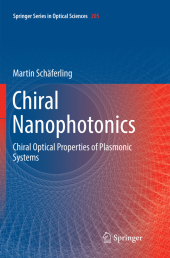 Neuerscheinungen 2018Stand: 2020-02-01 |
Schnellsuche
ISBN/Stichwort/Autor
|
Herderstraße 10
10625 Berlin
Tel.: 030 315 714 16
Fax 030 315 714 14
info@buchspektrum.de |

Martin Schäferling
Chiral Nanophotonics
Chiral Optical Properties of Plasmonic Systems
Softcover reprint of the original 1st ed. 2017. 2018. xv, 159 S. 4 SW-Abb., 75 Farbabb., 35 Farbtabelle
Verlag/Jahr: SPRINGER, BERLIN; SPRINGER INTERNATIONAL PUBLISHING 2018
ISBN: 3-319-82541-0 (3319825410)
Neue ISBN: 978-3-319-82541-0 (9783319825410)
Preis und Lieferzeit: Bitte klicken
This book describes the physics behind the optical properties of plasmonic nanostructures focusing on chiral aspects. It explains in detail how the geometry determines chiral near-fields and how to tailor their shape and strength. Electromagnetic fields with strong optical chirality interact strongly with chiral molecules and, therefore, can be used for enhancing the sensitivity of chiroptical spectroscopy techniques. Besides a short review of the latest results in the field of plasmonically enhanced enantiomer discrimination, this book introduces the concept of chiral plasmonic near-field sources for enhanced chiroptical spectroscopy. The discussion of the fundamental properties of these light sources provides the theoretical basis for further optimizations and is of interest for researchers at the intersection of nano-optics, plasmonics and stereochemistry.
Introduction.- Chirality in Nature and Science.- Chiroptical Spectroscopy- Chiral Properties of Light.- Enhancement of Chiral Fields by Geometrically Chiral Structures.- Chiral Fields of Macroscopically Achiral Arrangements.- Formation of Chiral Fields Near Symmetric Structures.- Chiral Eigenmodes of Geometrically Chiral Structures.- Conclusions and Outlook.
Martin Schäferling studied Physics and Computer Science in Münster. He was awarded for the best interdisciplinary diploma thesis in 2010. During his PhD in the group of Harald Giessen in Stuttgart, he investigated theoretical aspects of chiral plasmonics with a strong focus on tailored chiral near-fields. After he obtained his PhD in 2015, he joined the group of Thomas Weiss in Stuttgart, where he is currently working on advanced numerical and semi-analytical methods to study hybrid chiral plasmonic systems.


